BAA Terminal 5 Project: Risk Management, Procurement, and KPIs
VerifiedAdded on 2023/06/15
|9
|2214
|135
Report
AI Summary
This report provides a comprehensive analysis of risk and procurement management within the context of the BAA Terminal 5 project. It begins by outlining a bespoke risk management plan, complete with key performance indicators (KPIs) tailored to the specific challenges faced by the British Airport Authority (BAA), particularly regarding supplier relations and quality control. The report then delves into risk analysis, utilizing a risk register and probability impact model to assess various risks, including financial, supplier performance, construction, industrial relations, and procurement-related risks. The probability of these risks occurring is also evaluated. Furthermore, the report explores the application of Monte Carlo simulation as a decision-making tool, particularly in areas such as cost estimation, risk management, and commercial contract management. The analysis highlights the importance of stakeholder engagement, especially with suppliers, and the effectiveness of the T5 agreement in improving industrial relations and product quality. The report concludes by emphasizing the critical role of risk analysis in identifying and mitigating potential issues, advocating for the use of risk registers and impact probability analysis as effective risk management tools.
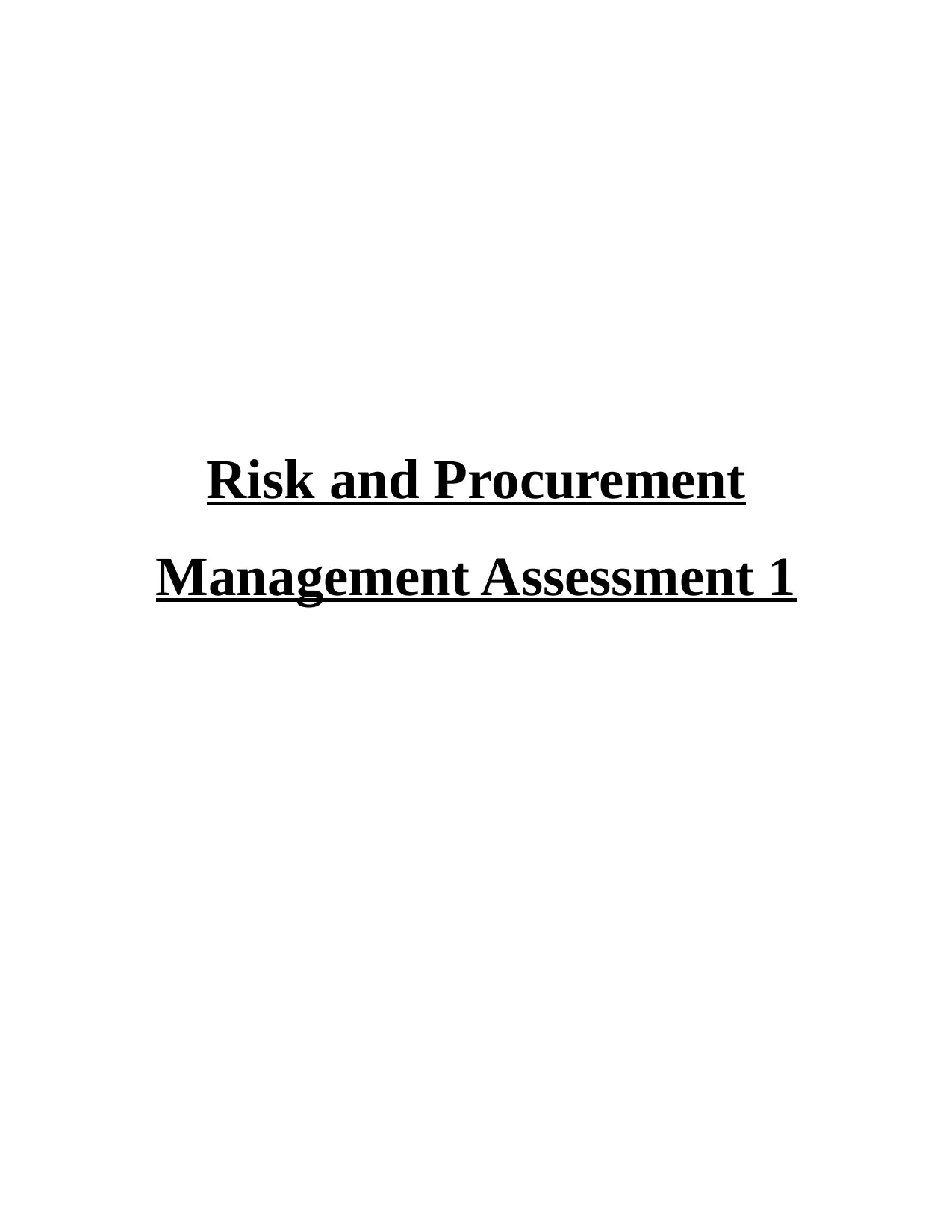
Risk and Procurement
Management Assessment 1
Management Assessment 1
Paraphrase This Document
Need a fresh take? Get an instant paraphrase of this document with our AI Paraphraser
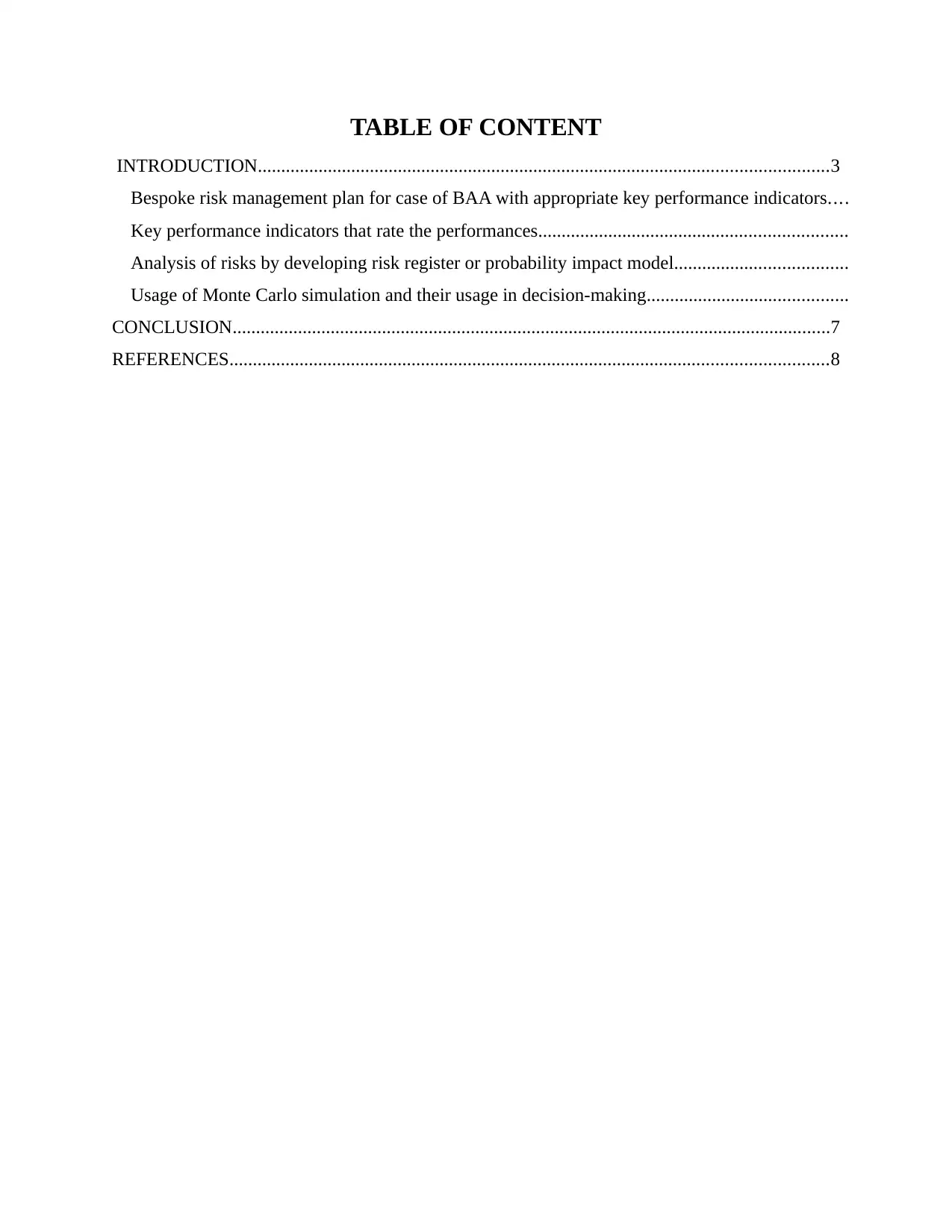
TABLE OF CONTENT
INTRODUCTION..........................................................................................................................3
Bespoke risk management plan for case of BAA with appropriate key performance indicators....
Key performance indicators that rate the performances..................................................................
Analysis of risks by developing risk register or probability impact model.....................................
Usage of Monte Carlo simulation and their usage in decision-making...........................................
CONCLUSION................................................................................................................................7
REFERENCES................................................................................................................................8
INTRODUCTION..........................................................................................................................3
Bespoke risk management plan for case of BAA with appropriate key performance indicators....
Key performance indicators that rate the performances..................................................................
Analysis of risks by developing risk register or probability impact model.....................................
Usage of Monte Carlo simulation and their usage in decision-making...........................................
CONCLUSION................................................................................................................................7
REFERENCES................................................................................................................................8
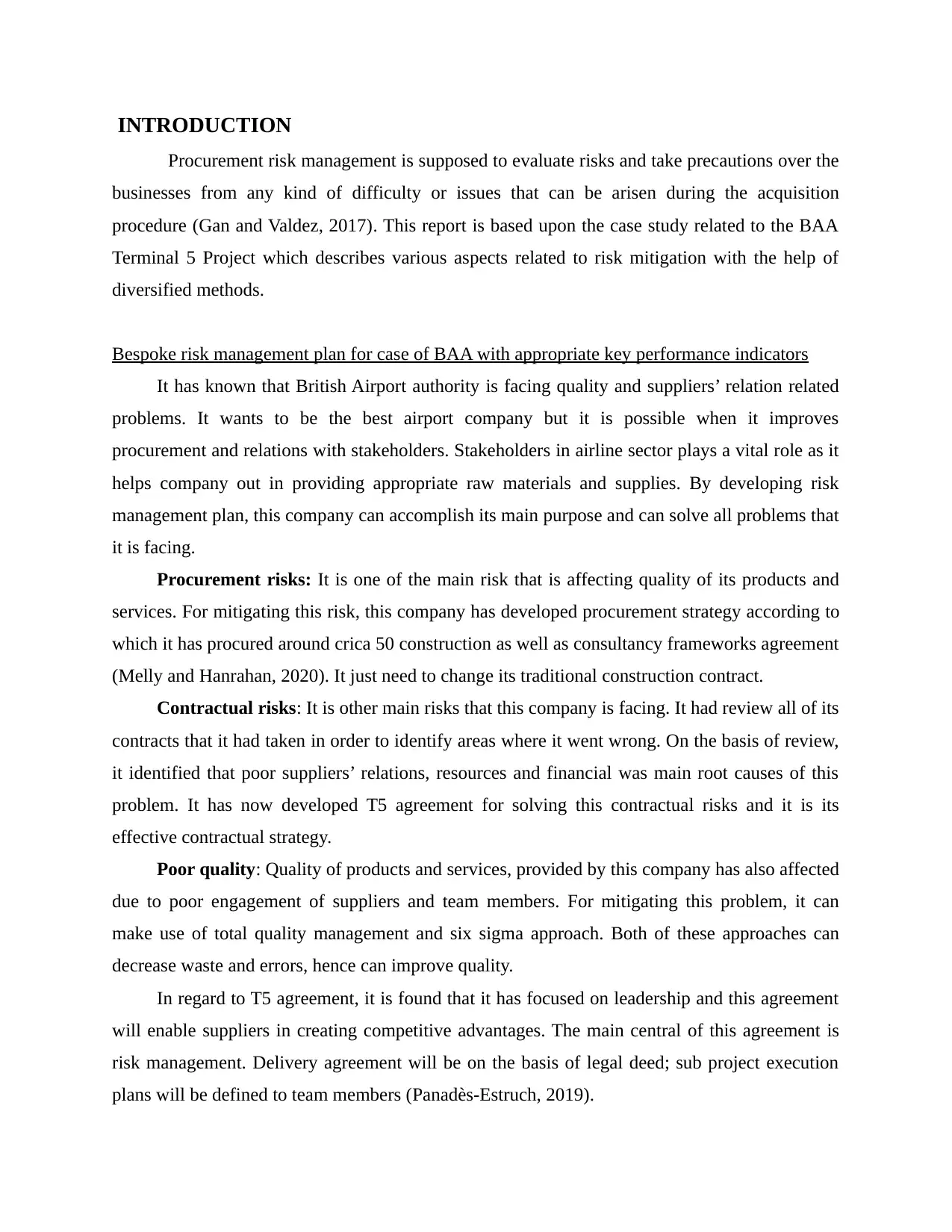
INTRODUCTION
Procurement risk management is supposed to evaluate risks and take precautions over the
businesses from any kind of difficulty or issues that can be arisen during the acquisition
procedure (Gan and Valdez, 2017). This report is based upon the case study related to the BAA
Terminal 5 Project which describes various aspects related to risk mitigation with the help of
diversified methods.
Bespoke risk management plan for case of BAA with appropriate key performance indicators
It has known that British Airport authority is facing quality and suppliers’ relation related
problems. It wants to be the best airport company but it is possible when it improves
procurement and relations with stakeholders. Stakeholders in airline sector plays a vital role as it
helps company out in providing appropriate raw materials and supplies. By developing risk
management plan, this company can accomplish its main purpose and can solve all problems that
it is facing.
Procurement risks: It is one of the main risk that is affecting quality of its products and
services. For mitigating this risk, this company has developed procurement strategy according to
which it has procured around crica 50 construction as well as consultancy frameworks agreement
(Melly and Hanrahan, 2020). It just need to change its traditional construction contract.
Contractual risks: It is other main risks that this company is facing. It had review all of its
contracts that it had taken in order to identify areas where it went wrong. On the basis of review,
it identified that poor suppliers’ relations, resources and financial was main root causes of this
problem. It has now developed T5 agreement for solving this contractual risks and it is its
effective contractual strategy.
Poor quality: Quality of products and services, provided by this company has also affected
due to poor engagement of suppliers and team members. For mitigating this problem, it can
make use of total quality management and six sigma approach. Both of these approaches can
decrease waste and errors, hence can improve quality.
In regard to T5 agreement, it is found that it has focused on leadership and this agreement
will enable suppliers in creating competitive advantages. The main central of this agreement is
risk management. Delivery agreement will be on the basis of legal deed; sub project execution
plans will be defined to team members (Panadès-Estruch, 2019).
Procurement risk management is supposed to evaluate risks and take precautions over the
businesses from any kind of difficulty or issues that can be arisen during the acquisition
procedure (Gan and Valdez, 2017). This report is based upon the case study related to the BAA
Terminal 5 Project which describes various aspects related to risk mitigation with the help of
diversified methods.
Bespoke risk management plan for case of BAA with appropriate key performance indicators
It has known that British Airport authority is facing quality and suppliers’ relation related
problems. It wants to be the best airport company but it is possible when it improves
procurement and relations with stakeholders. Stakeholders in airline sector plays a vital role as it
helps company out in providing appropriate raw materials and supplies. By developing risk
management plan, this company can accomplish its main purpose and can solve all problems that
it is facing.
Procurement risks: It is one of the main risk that is affecting quality of its products and
services. For mitigating this risk, this company has developed procurement strategy according to
which it has procured around crica 50 construction as well as consultancy frameworks agreement
(Melly and Hanrahan, 2020). It just need to change its traditional construction contract.
Contractual risks: It is other main risks that this company is facing. It had review all of its
contracts that it had taken in order to identify areas where it went wrong. On the basis of review,
it identified that poor suppliers’ relations, resources and financial was main root causes of this
problem. It has now developed T5 agreement for solving this contractual risks and it is its
effective contractual strategy.
Poor quality: Quality of products and services, provided by this company has also affected
due to poor engagement of suppliers and team members. For mitigating this problem, it can
make use of total quality management and six sigma approach. Both of these approaches can
decrease waste and errors, hence can improve quality.
In regard to T5 agreement, it is found that it has focused on leadership and this agreement
will enable suppliers in creating competitive advantages. The main central of this agreement is
risk management. Delivery agreement will be on the basis of legal deed; sub project execution
plans will be defined to team members (Panadès-Estruch, 2019).
⊘ This is a preview!⊘
Do you want full access?
Subscribe today to unlock all pages.

Trusted by 1+ million students worldwide
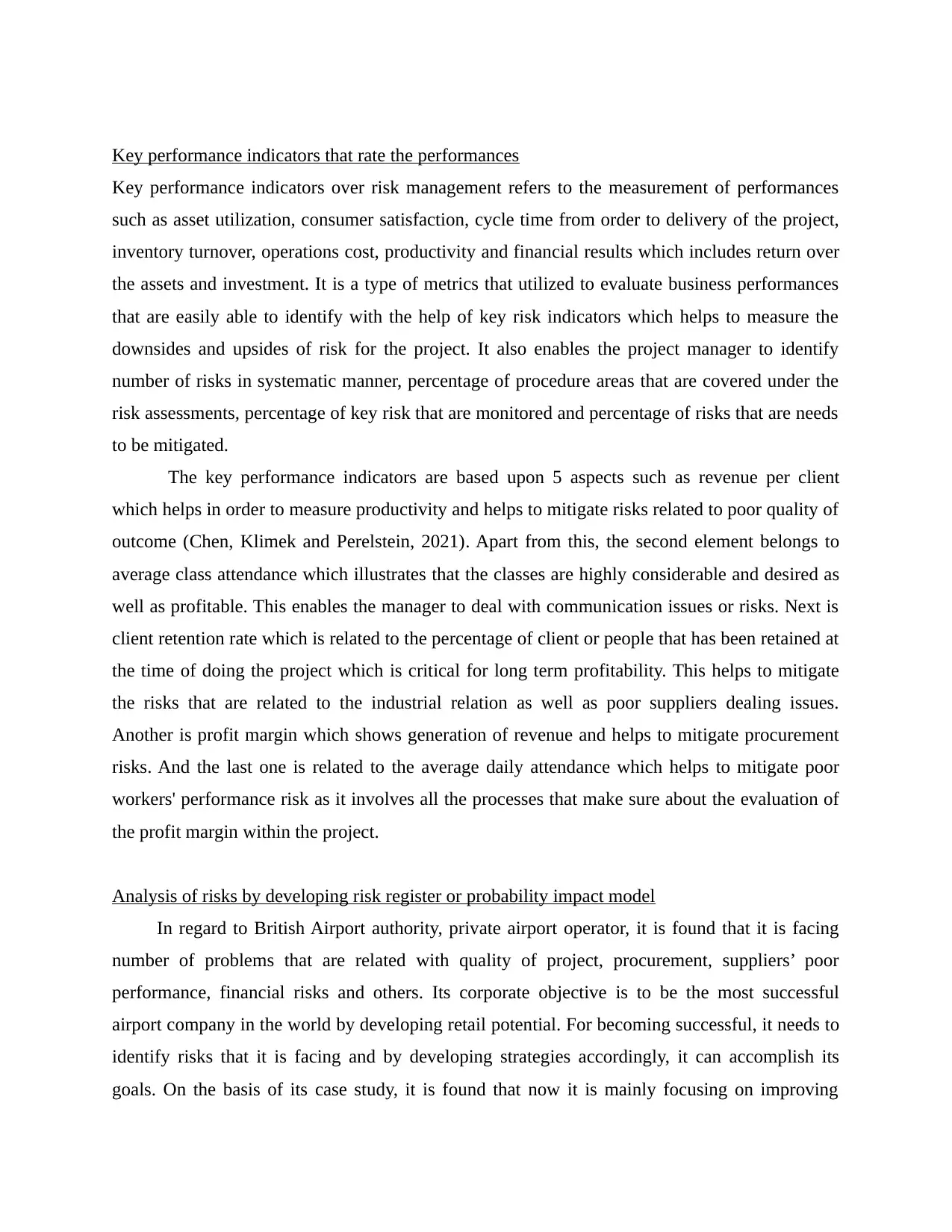
Key performance indicators that rate the performances
Key performance indicators over risk management refers to the measurement of performances
such as asset utilization, consumer satisfaction, cycle time from order to delivery of the project,
inventory turnover, operations cost, productivity and financial results which includes return over
the assets and investment. It is a type of metrics that utilized to evaluate business performances
that are easily able to identify with the help of key risk indicators which helps to measure the
downsides and upsides of risk for the project. It also enables the project manager to identify
number of risks in systematic manner, percentage of procedure areas that are covered under the
risk assessments, percentage of key risk that are monitored and percentage of risks that are needs
to be mitigated.
The key performance indicators are based upon 5 aspects such as revenue per client
which helps in order to measure productivity and helps to mitigate risks related to poor quality of
outcome (Chen, Klimek and Perelstein, 2021). Apart from this, the second element belongs to
average class attendance which illustrates that the classes are highly considerable and desired as
well as profitable. This enables the manager to deal with communication issues or risks. Next is
client retention rate which is related to the percentage of client or people that has been retained at
the time of doing the project which is critical for long term profitability. This helps to mitigate
the risks that are related to the industrial relation as well as poor suppliers dealing issues.
Another is profit margin which shows generation of revenue and helps to mitigate procurement
risks. And the last one is related to the average daily attendance which helps to mitigate poor
workers' performance risk as it involves all the processes that make sure about the evaluation of
the profit margin within the project.
Analysis of risks by developing risk register or probability impact model
In regard to British Airport authority, private airport operator, it is found that it is facing
number of problems that are related with quality of project, procurement, suppliers’ poor
performance, financial risks and others. Its corporate objective is to be the most successful
airport company in the world by developing retail potential. For becoming successful, it needs to
identify risks that it is facing and by developing strategies accordingly, it can accomplish its
goals. On the basis of its case study, it is found that now it is mainly focusing on improving
Key performance indicators over risk management refers to the measurement of performances
such as asset utilization, consumer satisfaction, cycle time from order to delivery of the project,
inventory turnover, operations cost, productivity and financial results which includes return over
the assets and investment. It is a type of metrics that utilized to evaluate business performances
that are easily able to identify with the help of key risk indicators which helps to measure the
downsides and upsides of risk for the project. It also enables the project manager to identify
number of risks in systematic manner, percentage of procedure areas that are covered under the
risk assessments, percentage of key risk that are monitored and percentage of risks that are needs
to be mitigated.
The key performance indicators are based upon 5 aspects such as revenue per client
which helps in order to measure productivity and helps to mitigate risks related to poor quality of
outcome (Chen, Klimek and Perelstein, 2021). Apart from this, the second element belongs to
average class attendance which illustrates that the classes are highly considerable and desired as
well as profitable. This enables the manager to deal with communication issues or risks. Next is
client retention rate which is related to the percentage of client or people that has been retained at
the time of doing the project which is critical for long term profitability. This helps to mitigate
the risks that are related to the industrial relation as well as poor suppliers dealing issues.
Another is profit margin which shows generation of revenue and helps to mitigate procurement
risks. And the last one is related to the average daily attendance which helps to mitigate poor
workers' performance risk as it involves all the processes that make sure about the evaluation of
the profit margin within the project.
Analysis of risks by developing risk register or probability impact model
In regard to British Airport authority, private airport operator, it is found that it is facing
number of problems that are related with quality of project, procurement, suppliers’ poor
performance, financial risks and others. Its corporate objective is to be the most successful
airport company in the world by developing retail potential. For becoming successful, it needs to
identify risks that it is facing and by developing strategies accordingly, it can accomplish its
goals. On the basis of its case study, it is found that now it is mainly focusing on improving
Paraphrase This Document
Need a fresh take? Get an instant paraphrase of this document with our AI Paraphraser
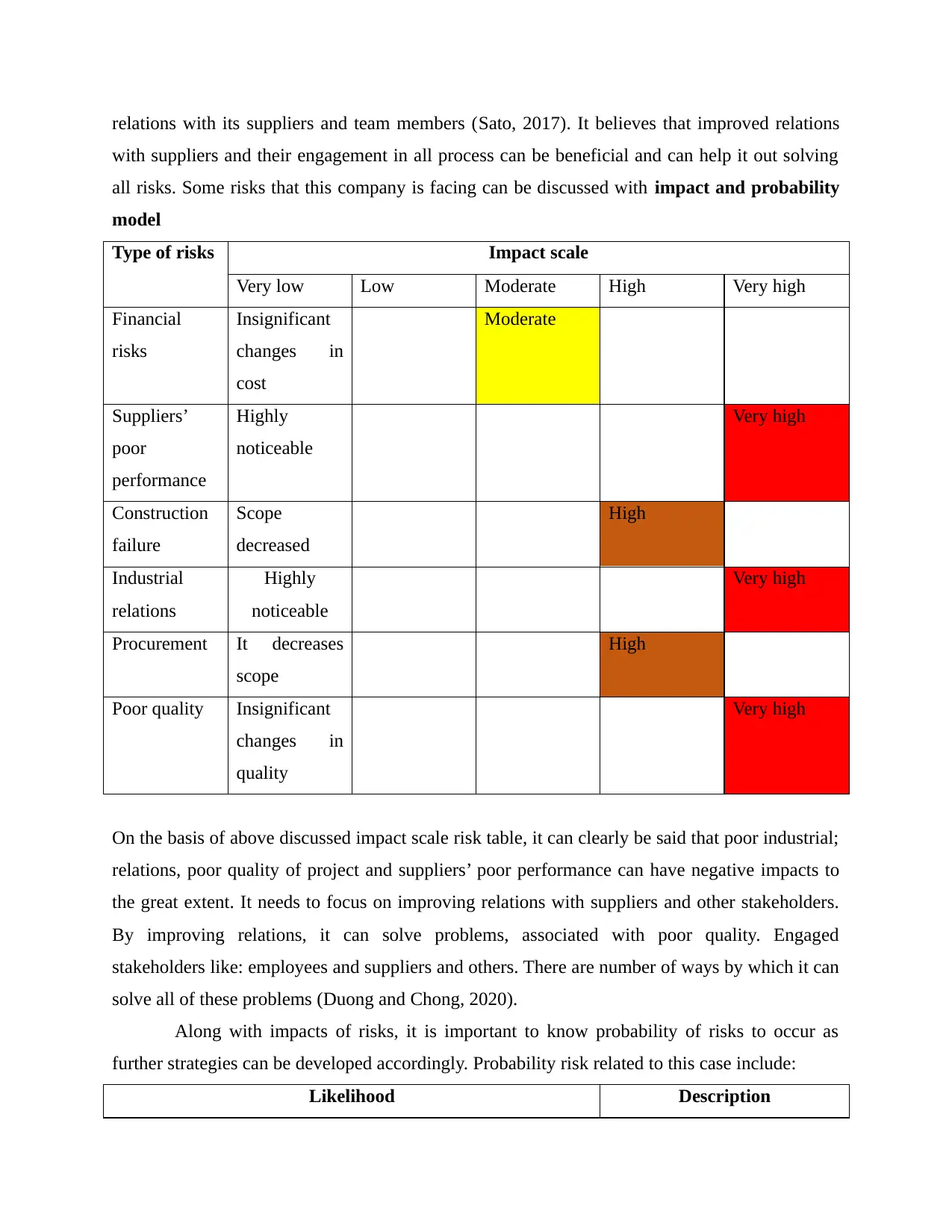
relations with its suppliers and team members (Sato, 2017). It believes that improved relations
with suppliers and their engagement in all process can be beneficial and can help it out solving
all risks. Some risks that this company is facing can be discussed with impact and probability
model
Type of risks Impact scale
Very low Low Moderate High Very high
Financial
risks
Insignificant
changes in
cost
Moderate
Suppliers’
poor
performance
Highly
noticeable
Very high
Construction
failure
Scope
decreased
High
Industrial
relations
Highly
noticeable
Very high
Procurement It decreases
scope
High
Poor quality Insignificant
changes in
quality
Very high
On the basis of above discussed impact scale risk table, it can clearly be said that poor industrial;
relations, poor quality of project and suppliers’ poor performance can have negative impacts to
the great extent. It needs to focus on improving relations with suppliers and other stakeholders.
By improving relations, it can solve problems, associated with poor quality. Engaged
stakeholders like: employees and suppliers and others. There are number of ways by which it can
solve all of these problems (Duong and Chong, 2020).
Along with impacts of risks, it is important to know probability of risks to occur as
further strategies can be developed accordingly. Probability risk related to this case include:
Likelihood Description
with suppliers and their engagement in all process can be beneficial and can help it out solving
all risks. Some risks that this company is facing can be discussed with impact and probability
model
Type of risks Impact scale
Very low Low Moderate High Very high
Financial
risks
Insignificant
changes in
cost
Moderate
Suppliers’
poor
performance
Highly
noticeable
Very high
Construction
failure
Scope
decreased
High
Industrial
relations
Highly
noticeable
Very high
Procurement It decreases
scope
High
Poor quality Insignificant
changes in
quality
Very high
On the basis of above discussed impact scale risk table, it can clearly be said that poor industrial;
relations, poor quality of project and suppliers’ poor performance can have negative impacts to
the great extent. It needs to focus on improving relations with suppliers and other stakeholders.
By improving relations, it can solve problems, associated with poor quality. Engaged
stakeholders like: employees and suppliers and others. There are number of ways by which it can
solve all of these problems (Duong and Chong, 2020).
Along with impacts of risks, it is important to know probability of risks to occur as
further strategies can be developed accordingly. Probability risk related to this case include:
Likelihood Description
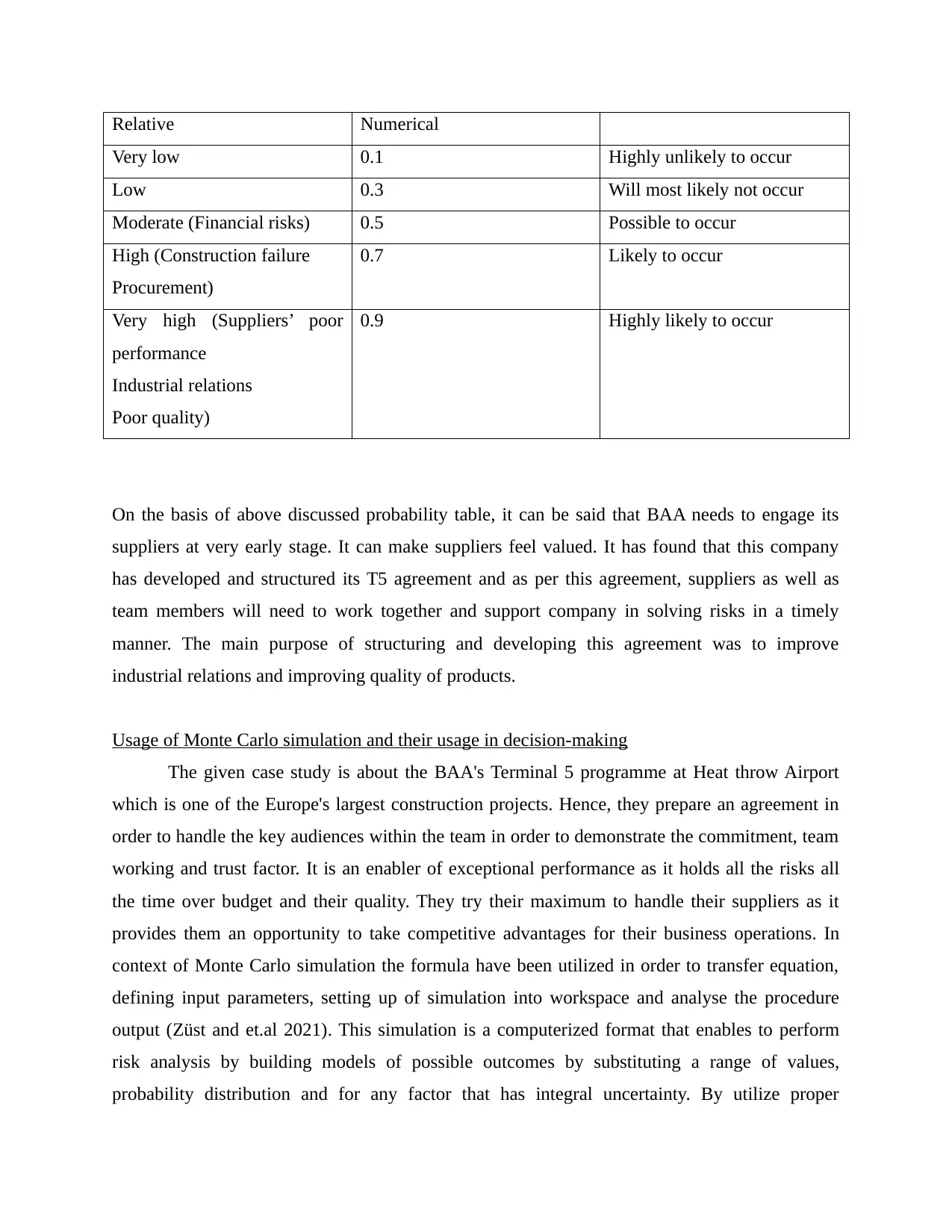
Relative Numerical
Very low 0.1 Highly unlikely to occur
Low 0.3 Will most likely not occur
Moderate (Financial risks) 0.5 Possible to occur
High (Construction failure
Procurement)
0.7 Likely to occur
Very high (Suppliers’ poor
performance
Industrial relations
Poor quality)
0.9 Highly likely to occur
On the basis of above discussed probability table, it can be said that BAA needs to engage its
suppliers at very early stage. It can make suppliers feel valued. It has found that this company
has developed and structured its T5 agreement and as per this agreement, suppliers as well as
team members will need to work together and support company in solving risks in a timely
manner. The main purpose of structuring and developing this agreement was to improve
industrial relations and improving quality of products.
Usage of Monte Carlo simulation and their usage in decision-making
The given case study is about the BAA's Terminal 5 programme at Heat throw Airport
which is one of the Europe's largest construction projects. Hence, they prepare an agreement in
order to handle the key audiences within the team in order to demonstrate the commitment, team
working and trust factor. It is an enabler of exceptional performance as it holds all the risks all
the time over budget and their quality. They try their maximum to handle their suppliers as it
provides them an opportunity to take competitive advantages for their business operations. In
context of Monte Carlo simulation the formula have been utilized in order to transfer equation,
defining input parameters, setting up of simulation into workspace and analyse the procedure
output (Züst and et.al 2021). This simulation is a computerized format that enables to perform
risk analysis by building models of possible outcomes by substituting a range of values,
probability distribution and for any factor that has integral uncertainty. By utilize proper
Very low 0.1 Highly unlikely to occur
Low 0.3 Will most likely not occur
Moderate (Financial risks) 0.5 Possible to occur
High (Construction failure
Procurement)
0.7 Likely to occur
Very high (Suppliers’ poor
performance
Industrial relations
Poor quality)
0.9 Highly likely to occur
On the basis of above discussed probability table, it can be said that BAA needs to engage its
suppliers at very early stage. It can make suppliers feel valued. It has found that this company
has developed and structured its T5 agreement and as per this agreement, suppliers as well as
team members will need to work together and support company in solving risks in a timely
manner. The main purpose of structuring and developing this agreement was to improve
industrial relations and improving quality of products.
Usage of Monte Carlo simulation and their usage in decision-making
The given case study is about the BAA's Terminal 5 programme at Heat throw Airport
which is one of the Europe's largest construction projects. Hence, they prepare an agreement in
order to handle the key audiences within the team in order to demonstrate the commitment, team
working and trust factor. It is an enabler of exceptional performance as it holds all the risks all
the time over budget and their quality. They try their maximum to handle their suppliers as it
provides them an opportunity to take competitive advantages for their business operations. In
context of Monte Carlo simulation the formula have been utilized in order to transfer equation,
defining input parameters, setting up of simulation into workspace and analyse the procedure
output (Züst and et.al 2021). This simulation is a computerized format that enables to perform
risk analysis by building models of possible outcomes by substituting a range of values,
probability distribution and for any factor that has integral uncertainty. By utilize proper
⊘ This is a preview!⊘
Do you want full access?
Subscribe today to unlock all pages.

Trusted by 1+ million students worldwide
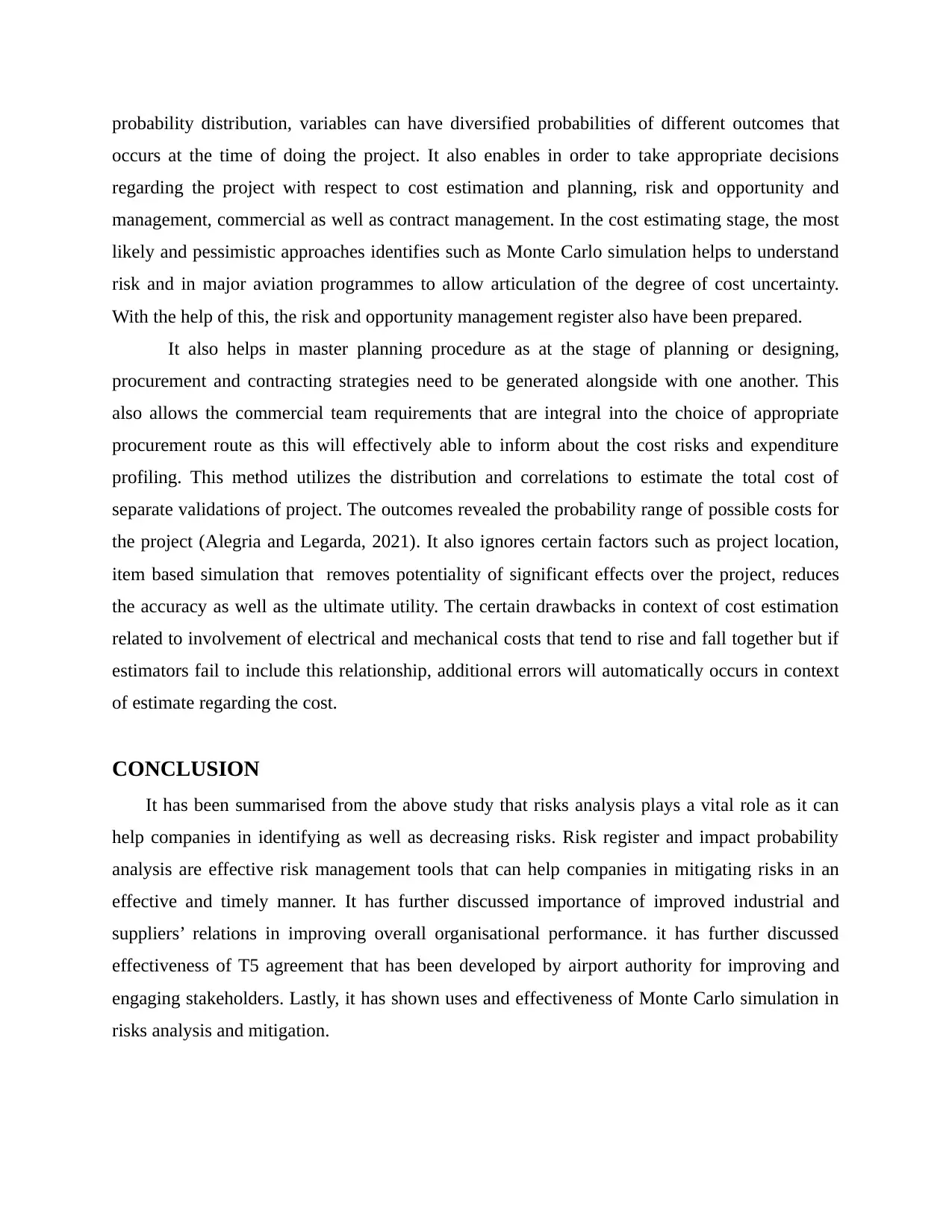
probability distribution, variables can have diversified probabilities of different outcomes that
occurs at the time of doing the project. It also enables in order to take appropriate decisions
regarding the project with respect to cost estimation and planning, risk and opportunity and
management, commercial as well as contract management. In the cost estimating stage, the most
likely and pessimistic approaches identifies such as Monte Carlo simulation helps to understand
risk and in major aviation programmes to allow articulation of the degree of cost uncertainty.
With the help of this, the risk and opportunity management register also have been prepared.
It also helps in master planning procedure as at the stage of planning or designing,
procurement and contracting strategies need to be generated alongside with one another. This
also allows the commercial team requirements that are integral into the choice of appropriate
procurement route as this will effectively able to inform about the cost risks and expenditure
profiling. This method utilizes the distribution and correlations to estimate the total cost of
separate validations of project. The outcomes revealed the probability range of possible costs for
the project (Alegria and Legarda, 2021). It also ignores certain factors such as project location,
item based simulation that removes potentiality of significant effects over the project, reduces
the accuracy as well as the ultimate utility. The certain drawbacks in context of cost estimation
related to involvement of electrical and mechanical costs that tend to rise and fall together but if
estimators fail to include this relationship, additional errors will automatically occurs in context
of estimate regarding the cost.
CONCLUSION
It has been summarised from the above study that risks analysis plays a vital role as it can
help companies in identifying as well as decreasing risks. Risk register and impact probability
analysis are effective risk management tools that can help companies in mitigating risks in an
effective and timely manner. It has further discussed importance of improved industrial and
suppliers’ relations in improving overall organisational performance. it has further discussed
effectiveness of T5 agreement that has been developed by airport authority for improving and
engaging stakeholders. Lastly, it has shown uses and effectiveness of Monte Carlo simulation in
risks analysis and mitigation.
occurs at the time of doing the project. It also enables in order to take appropriate decisions
regarding the project with respect to cost estimation and planning, risk and opportunity and
management, commercial as well as contract management. In the cost estimating stage, the most
likely and pessimistic approaches identifies such as Monte Carlo simulation helps to understand
risk and in major aviation programmes to allow articulation of the degree of cost uncertainty.
With the help of this, the risk and opportunity management register also have been prepared.
It also helps in master planning procedure as at the stage of planning or designing,
procurement and contracting strategies need to be generated alongside with one another. This
also allows the commercial team requirements that are integral into the choice of appropriate
procurement route as this will effectively able to inform about the cost risks and expenditure
profiling. This method utilizes the distribution and correlations to estimate the total cost of
separate validations of project. The outcomes revealed the probability range of possible costs for
the project (Alegria and Legarda, 2021). It also ignores certain factors such as project location,
item based simulation that removes potentiality of significant effects over the project, reduces
the accuracy as well as the ultimate utility. The certain drawbacks in context of cost estimation
related to involvement of electrical and mechanical costs that tend to rise and fall together but if
estimators fail to include this relationship, additional errors will automatically occurs in context
of estimate regarding the cost.
CONCLUSION
It has been summarised from the above study that risks analysis plays a vital role as it can
help companies in identifying as well as decreasing risks. Risk register and impact probability
analysis are effective risk management tools that can help companies in mitigating risks in an
effective and timely manner. It has further discussed importance of improved industrial and
suppliers’ relations in improving overall organisational performance. it has further discussed
effectiveness of T5 agreement that has been developed by airport authority for improving and
engaging stakeholders. Lastly, it has shown uses and effectiveness of Monte Carlo simulation in
risks analysis and mitigation.
Paraphrase This Document
Need a fresh take? Get an instant paraphrase of this document with our AI Paraphraser

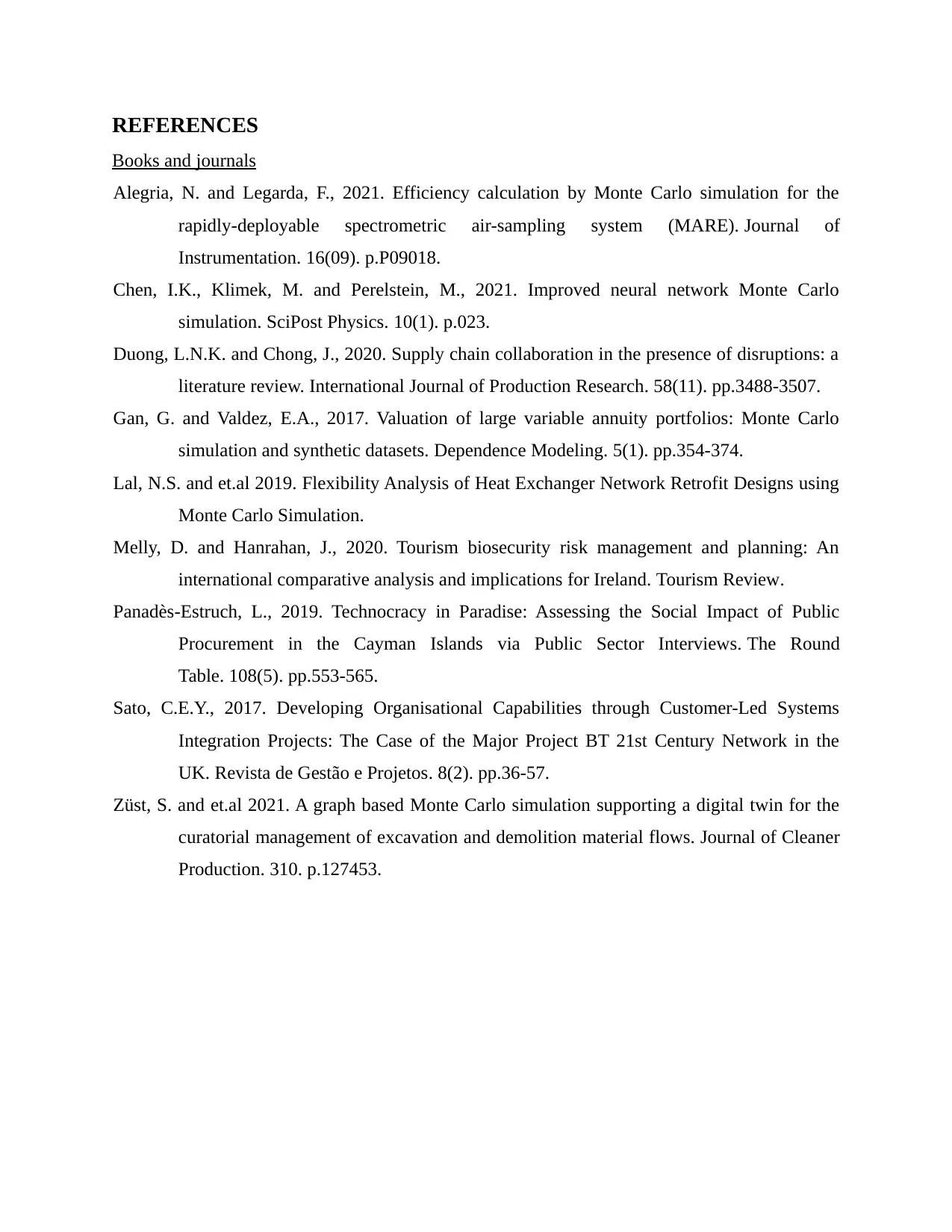
REFERENCES
Books and journals
Alegria, N. and Legarda, F., 2021. Efficiency calculation by Monte Carlo simulation for the
rapidly-deployable spectrometric air-sampling system (MARE). Journal of
Instrumentation. 16(09). p.P09018.
Chen, I.K., Klimek, M. and Perelstein, M., 2021. Improved neural network Monte Carlo
simulation. SciPost Physics. 10(1). p.023.
Duong, L.N.K. and Chong, J., 2020. Supply chain collaboration in the presence of disruptions: a
literature review. International Journal of Production Research. 58(11). pp.3488-3507.
Gan, G. and Valdez, E.A., 2017. Valuation of large variable annuity portfolios: Monte Carlo
simulation and synthetic datasets. Dependence Modeling. 5(1). pp.354-374.
Lal, N.S. and et.al 2019. Flexibility Analysis of Heat Exchanger Network Retrofit Designs using
Monte Carlo Simulation.
Melly, D. and Hanrahan, J., 2020. Tourism biosecurity risk management and planning: An
international comparative analysis and implications for Ireland. Tourism Review.
Panadès-Estruch, L., 2019. Technocracy in Paradise: Assessing the Social Impact of Public
Procurement in the Cayman Islands via Public Sector Interviews. The Round
Table. 108(5). pp.553-565.
Sato, C.E.Y., 2017. Developing Organisational Capabilities through Customer-Led Systems
Integration Projects: The Case of the Major Project BT 21st Century Network in the
UK. Revista de Gestão e Projetos. 8(2). pp.36-57.
Züst, S. and et.al 2021. A graph based Monte Carlo simulation supporting a digital twin for the
curatorial management of excavation and demolition material flows. Journal of Cleaner
Production. 310. p.127453.
Books and journals
Alegria, N. and Legarda, F., 2021. Efficiency calculation by Monte Carlo simulation for the
rapidly-deployable spectrometric air-sampling system (MARE). Journal of
Instrumentation. 16(09). p.P09018.
Chen, I.K., Klimek, M. and Perelstein, M., 2021. Improved neural network Monte Carlo
simulation. SciPost Physics. 10(1). p.023.
Duong, L.N.K. and Chong, J., 2020. Supply chain collaboration in the presence of disruptions: a
literature review. International Journal of Production Research. 58(11). pp.3488-3507.
Gan, G. and Valdez, E.A., 2017. Valuation of large variable annuity portfolios: Monte Carlo
simulation and synthetic datasets. Dependence Modeling. 5(1). pp.354-374.
Lal, N.S. and et.al 2019. Flexibility Analysis of Heat Exchanger Network Retrofit Designs using
Monte Carlo Simulation.
Melly, D. and Hanrahan, J., 2020. Tourism biosecurity risk management and planning: An
international comparative analysis and implications for Ireland. Tourism Review.
Panadès-Estruch, L., 2019. Technocracy in Paradise: Assessing the Social Impact of Public
Procurement in the Cayman Islands via Public Sector Interviews. The Round
Table. 108(5). pp.553-565.
Sato, C.E.Y., 2017. Developing Organisational Capabilities through Customer-Led Systems
Integration Projects: The Case of the Major Project BT 21st Century Network in the
UK. Revista de Gestão e Projetos. 8(2). pp.36-57.
Züst, S. and et.al 2021. A graph based Monte Carlo simulation supporting a digital twin for the
curatorial management of excavation and demolition material flows. Journal of Cleaner
Production. 310. p.127453.
⊘ This is a preview!⊘
Do you want full access?
Subscribe today to unlock all pages.

Trusted by 1+ million students worldwide
1 out of 9
Related Documents
Your All-in-One AI-Powered Toolkit for Academic Success.
+13062052269
info@desklib.com
Available 24*7 on WhatsApp / Email
![[object Object]](/_next/static/media/star-bottom.7253800d.svg)
Unlock your academic potential
Copyright © 2020–2025 A2Z Services. All Rights Reserved. Developed and managed by ZUCOL.


